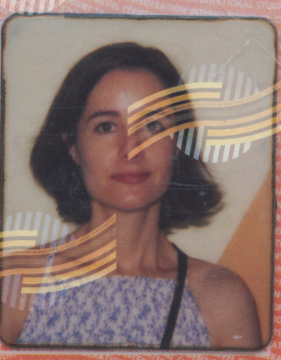TDR Interview: Andrea Ryder
 |
Andrea Ryder is the editor-in-chief of
Slingshot magazine, a literary and
arts magazine, and a Canadian photographer working in New York City. Ryder
has milked cows on a Kibbutz in the Upper Galilee, Israel, taught
Shakespearean literature to high school children in Rae Bareli, India,
worked as an archaeologist in Belize, uncovering Mayan ceremonial stairs,
works for an arts institute that is in India organizing exchanges with
artists and students from the west and is the house photographer for the
hebrew pentecostals of Brooklyn, New York.
The photo below is © A. Ryder Photograph, 2003.
|
 Michael interviewed Andrea in July 2003. Michael interviewed Andrea in July 2003.
Tell us a little about your journey. Who are you? What are some of the prime
influences that have brought you to where you are?
During the summer when I was 16 I was lucky enough to go on a 40-day canoe
trip. Eight of us traveled by foot and canoe from Ontario into Quebec.
Kipawa, the name of the canoe trip, was arduous and beautiful. The rhythm,
the enigma of arrival, and a constant sense of movement, and discovery.
Kipawa really instilled in me a sense of wonder and adventure. Since then,
travel has been a huge inspiration, specifically travel with work. If I
work, then I am more apart then just passing through. Another big turning
point happened when I declined a Commonwealth Scholarship to study
Comparative Religion or Art and Architecture, a master's degree in India. A
death in the family, was in love. I was so lost after giving up the
scholarship - what would have surely been a pivotal experience, that I
shaved my head and began painting. I even lived for a while in an artist's
co-operative in Toronto. Before moving to Brooklyn, I was in Montreal for
about five years where I both painted and made photographs.
What's your current (photography) project?
I am trying to take images from series of images, and make them become
things perceived as metaphoric mirrors. All about the subjectivity is
viewer. So, I try and create a vacuum within my own imagery for the viewer
to look through and see things slightly iconic, slightly familiar, slightly
foreign.
Tell us a little about Slingshot. What is the magazine about?
It is a literary and arts magazine. I don't want to write too much about it;
it should speak for itself. The design of the webpage and hardcopies are
clean. I offer no commentaries or explanations, or reviews. None of that.
Just poetry and visual arts.
What are some of its highlights so far?
The greatest thrill is to get hard copies back from the printers. Another
one is to meet talented authors and artists. And to receive submissions as
far as Bulgaria, Paris, Prague...
You're a Canadian living in the USA, publishing a literary and visual arts
magazine (among other endeavors). How's the view from there? Has your
perception of Canadian literature changed since you've moved stateside?
In terms of the U.S.' perception of Canadian literature, Americans are
finally acknowledging that we not only produce comedians (they love our
comedians), but we are multitalented, and yes, have many talented writers,
too. Life of Pi by Yann Martel has been on the NY Times best seller list for
weeks. Alice Munro is often published in the New Yorker. And these are just
the obvious ones. I maintain a high perception of Canadian literature. I
love visual text-plays, and first admired that in a poem by a female
Canadian poet, Diana Tegenkamp.
You're working with an art institute in India. Could you tell us a bit about
what that's about and what it's like?
The international institute of fine arts is about 40 minutes north west of
Delhi, in a factory town off the beaten track of travelers, called
Modinagar. It is a rather cool, somewhat raw place with monkeys, huge
studios with Indian arches, little gardens with ancient vines ... and
outside this textile factory compound is a bustling, loud, rough plebian,
town connected by rail to the rest of India. During my last long visit
there, in 2000, I set up a darkroom, taught pinhole photography, wrote a
university curriculum and negotiated with a local and established university
to affiliate with us. It is full - we have about 60 students each year, in a
four-year bachelor's program. New York University art students and other
interested artists and students can go there to share and swap techniques
with Indian artists/students. There is a whole avant movement in India today
with very sophisticated, abstract thinkers, and with such an old, sometimes
traditional and oftentimes zany backdrop, inspiration is vivid, visceral.
What's next for you? Any projects you're itching to get started?
That's about it - except for a couple of travel dreams.
Michael Bryson is the
publisher/editor of The Danforth Review.
|